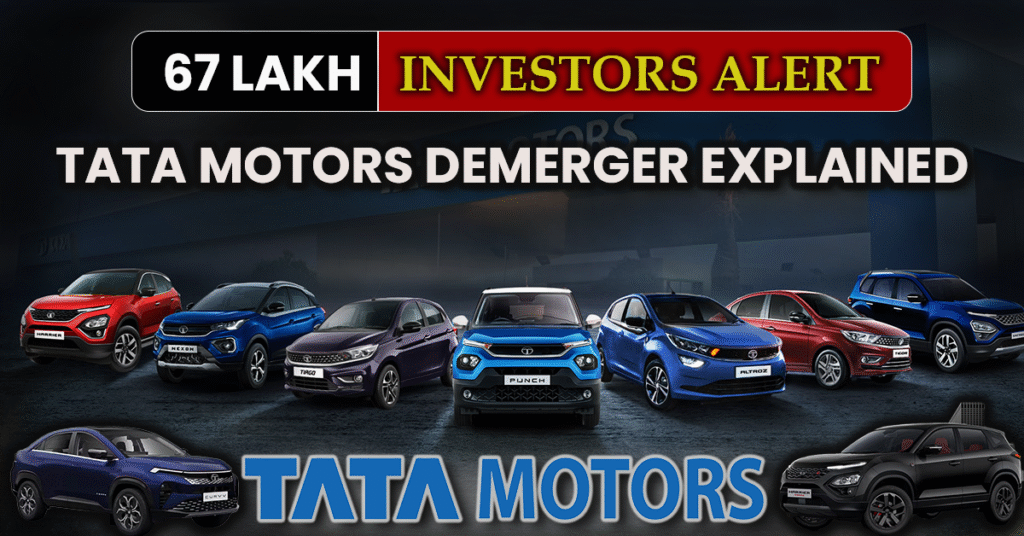
The dust has hardly subsided over the long-awaited Tata Motors demerger, and the next major milestone of listing its newly constituted entities is now in sight. The demerger is the turning point in the history of one of the most credible automotive giants in India, with more than 67 lakh shareholders in the company having a stake in it.
The Division that reinvents Tata Motors
The board of Tata Motors had previously accepted a strategic division of the company in two different entities, Tata Motors Passenger Vehicles Ltd. (TMPVL) and Tata Motors Commercial Vehicles Ltd. (TMCVL). The action was meant to provide greater operational focus, accountability and unlocking of long-term shareholder value.
The passenger vehicles business will consist of the domestic PV business, the electric vehicle vertical that is growing rapidly (Tata Passenger Electric Mobility), and the investment of Tata Motors in Jaguar Land Rover (JLR). Meanwhile, the commercial vehicles division will have the medium and heavy commercial vehicle (MHCV), the intermediate and light commercial vehicle (ILCV) and the small commercial vehicle (SCV) segments and their respective financing businesses.
This demerger, which is one of the biggest restructurings in Indian corporate history, is regarded as an attempt to provide sanity to the investor mindset, investors who have long considered Tata Motors as a moving parts conglomerate.
Listing Date and Market Expectations
Company insiders, as well as market reports, indicate that the listing of the newly formed entities is likely to occur in the first half of 2025, pending the relevant regulatory and shareholder approvals. The date of record of share allocation is most likely to be declared in the next few months.
After the listing, current shareholders of Tata Motors will be awarded shares in both companies in a ratio which will be determined by the board, most probably in a 1-1 form, but the actual information remains unofficial.
The merger of the two listed companies is predicted by market analysts to have a valuation higher than the current market capitalisation of Tata Motors due to the potential rise in the EV and passenger car market. The passenger vehicles business, which has a good momentum of models such as the Nexon, Punch and the growing EV portfolio, is expected to receive high premium values as other standalone EV players and other international players.
Although the commercial vehicles segment is in short-term headwinds because of the cyclical demand, it is likely to be positively affected by the increase in infrastructure and government logistics and transportation expenditures.
Impact on Shareholders
To the 67 lakh shareholders of Tata Motors, the demerger implies pure ownership in two narrow companies with their management team and strategic plan of action. Such a structure will likely facilitate easier valuation of each business by the investors.
The move has been mostly received well by the institutional investors, who termed as a value-unlocking step and which will enhance transparency and corporate governance. Even the retail shareholders will be expected to enjoy the improved transparency of the performance of each segment.
Analysts think that there may be some short-term volatility in the share prices because, first, the investors have to rebalance their portfolios due to the listing. Nevertheless, demerger will probably increase returns in the long term.
What Analysts Are Saying
The announcement has made brokerages start reassigning their price targets of Tata Motors. Several analysts have improved the stock based on the demerger as a structural positive that can assist the company in realising focused growth.
According to Motilal Oswal, the demerger would enable separate allocation of capital between the two business ventures, whereas ICICI Securities proposed that the demerger could re-rate the passenger vehicle business of Tata Motors due to the increasing EV push.
In the meantime, Jefferies India has indicated that the possible separation of the CV and PV business might enable Tata Motors to draw in specialisation investors, who like to have a sector-specific exposure, as was done by global automakers.
What’s Next
Once the demerger becomes effective, both entities will operate under independent boards and management teams, though Tata Sons will remain the principal promoter for both. The next step involves regulatory filings with the NCLT and SEBI, followed by shareholder approval.
Post-approval, Tata Motors will issue new shares corresponding to the demerged entity. The shares will then be credited to investors’ demat accounts ahead of their listing on the NSE and BSE.
The transition phase will also see the company reworking its brand and operational identity to ensure that both businesses retain Tata’s core values of trust, quality, and innovation.
The Broader Picture
In the case of the Indian automobile industry, the demerger of Tata Motors will create a precedent for other conglomerates that have diversified portfolios. It highlights a larger trend in Indian corporate life of streamlining structures and adding more operational orientation to attract international investors.`
It is the next chapter of the evolution of Tata Motors, which has ceased to be a truck manufacturer but has now become a diversified powerhouse in the automobile industry. With the company set to undergo a dual listing, the 67 lakh shareholders will be in a position to experience a historical shift that will mark the company in a new positioning in the market in the decades to come.
Although the road ahead may have temporary deviations, the demerger is the beginning of the new era of Tata Motors, as the two combustion engines of growth in the commercial and passenger cars are finally going to operate on separate but parallel paths.
A digital marketer possessing excellent knowledge and skill in off-page, on page and local SEO is competent in the challenging environment. Hard-working, energetic, and a quick learner for any task delegated. Enthusiastic to learn and constantly upgrade knowledge. Mohit brings over 2 years of experience in crafting content that not only ranks well but also provides valuable insights to readers.

